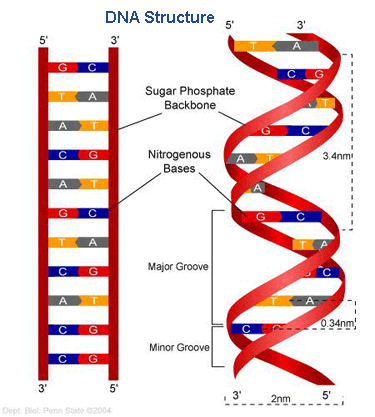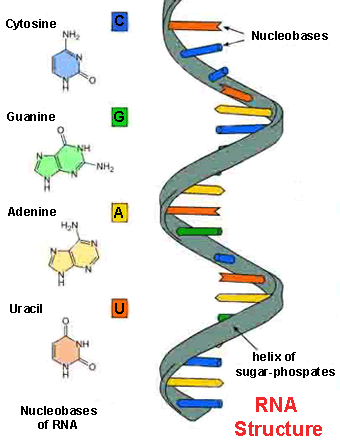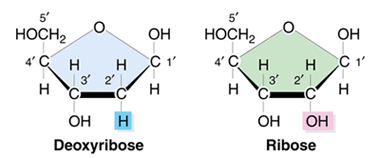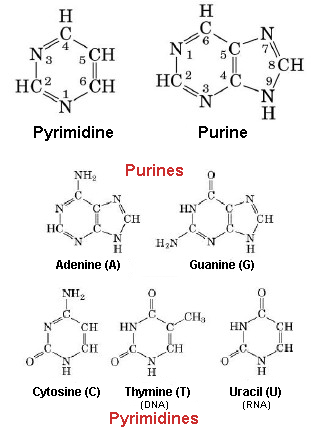DNA and RNA are the most important biological macromolecules for the continuity of life.
DNA molecules contain the genetic material of all living organisms, from bacteria to multicellular mammals.
In prokaryotic cells DNA is not enclosed inside a membranous envelope, but is in eukaryotic cells where it is located inside the nucleus and organelles.
DNA molecules contain the genetic material of all living organisms, from bacteria to multicellular mammals.
In prokaryotic cells DNA is not enclosed inside a membranous envelope, but is in eukaryotic cells where it is located inside the nucleus and organelles.
In eukaryotic cells, DNA along with some proteins, called histones, form chromatin (the material from which eukaryotic chromosomes are made), which can contain tens of thousands of genes.
DNA is in charge of controlling the activity of cells by activating and deactivating genes.
DNA is in charge of controlling the activity of cells by activating and deactivating genes.
The other kind of nucleic acid, RNA, primarily conducts protein synthesis and its regulation through the action of three different sorts of RNA (rRNA or ribosomal RNA, tRNA or transfer RNA and miRNA or microRNA). The fourth type of RNA (mRNA or messenger RNA) acts as communication intermediary between DNA and the rest of the cell.


Nucleotides are nucleic acid monomers, which are combined to generate their polynucleotides (DNA and RNA). Each nucleotide is composed of three components: one nitrogenous base attached to a pentose sugar molecule, which, in turn, is attached to a phosphate group.
Nitrogenous bases are organic molecules made up of carbon (C) and nitrogen (N) that are divided into five kinds: adenine (A) and guanine (G) are known as purines, they have two fused rings of C-N. Cytosine (C), thymine (T) and uracil (U) are known as pyrimidines, they only have a fused ring of C-N.
Both purines and pyrimidines have different functional groups attached to these rings.
The DNA molecule comprises A, T, G and C, while the RNA molecule comprises A, U, G and C, therefore, tymine is substituted by uracil.
Another difference between DNA and RNA is that DNA sugar molecule is a deoxyribose (they have a hydrogen atom attached to the second carbon atom of the molecule) whereas RNA sugar molecule is a ribose (they have a hydroxyl group attached to that second carbon atom instead).

Carbon atoms of the sugar molecule are numbered as 1´, 2´, 3´, 4´ and 5´. The phosphate residue joins the hydroxyl group of the 5´carbon and the 3´ carbon of the sugar molecule of the next nucleotide forming a phosphodiester linkage between them.
Both purines and pyrimidines have different functional groups attached to these rings.
The DNA molecule comprises A, T, G and C, while the RNA molecule comprises A, U, G and C, therefore, tymine is substituted by uracil.

Carbon atoms of the sugar molecule are numbered as 1´, 2´, 3´, 4´ and 5´. The phosphate residue joins the hydroxyl group of the 5´carbon and the 3´ carbon of the sugar molecule of the next nucleotide forming a phosphodiester linkage between them.
DNA double-helix structure
In the DNA double-helix structure, the sugar molecule and phosphate group are located outside this structure, whereas the nitrogenous bases lie in the interior like the rungs of a ladder linked by hydrogen bonds, in such a way that A can only pair with T and G can only pair with C. This rule is known as the rule of complementary base pairing.
Each of these pairs is separated from the next one by 0.34 nm; both strands of the double-helix run in opposite directions in such a way that the 5' carbon of one strand faces the 3' carbon of the complementary strand.
Each of these pairs is separated from the next one by 0.34 nm; both strands of the double-helix run in opposite directions in such a way that the 5' carbon of one strand faces the 3' carbon of the complementary strand.
During DNA replication, each of these strands are separated and they are used to synthesise a new complementary strand, in such a way that each daughter DNA double helix contains a new synthesised strand and one parental DNA strand.
RNA
Normally, RNA comprises a single ribonucleotide strand held together by phosphodiester bonds. These ribonucleotides contain, in turn, a phosphate group, a ribose molecule (pentose sugar) and one of the four nitrogenous bases (A, U, C and G).
The DNA that controls the activity of the cell uses the mRNA (messenger RNA) to carry its message
Thus, if a cell requires a certain protein, the gene for this product is activated and the nucleus synthesises the mRNA. This mRNA has a complementary sequence to the coding sequence of the DNA has been copied from.
The mRNA crosses the nuclear membrane, gets to the cytoplasm and there it interacts with the ribosomes and other cellular machinery.
To produce the required protein, the mRNA is read in groups of three bases called codons. Each codon codifies a single amino acid.
Thus, if a cell requires a certain protein, the gene for this product is activated and the nucleus synthesises the mRNA. This mRNA has a complementary sequence to the coding sequence of the DNA has been copied from.
The mRNA crosses the nuclear membrane, gets to the cytoplasm and there it interacts with the ribosomes and other cellular machinery.
To produce the required protein, the mRNA is read in groups of three bases called codons. Each codon codifies a single amino acid.
The second kind of RNA, rRNA, is responsible for the suitable alignment between the mRNA and ribosomes. It also has an enzymatic activity and catalyses the formation of peptide bonds between two aligned amino acids.
The tRNA is in charge of transporting the correct amino acid to the site where the protein synthesis takes place. The base pairing between the tRNA and the mRNA allows for the appropriate amino acid to be inserted in the polypeptide chain.
Lastly, the major function of the microRNA (the smallest of all types of RNA) is the regulation of gene expression by interfering with the expression of certain messages of the mRNA.
Hence, in an organism the information goes from DNA to RNA and from this one to proteins. During the first stage (transcription), the DNA dictates the structure of mRNA and during the second (translation), RNA rules the structure of a specific protein.
This process is known as the central dogma of molecular biology, which is valid for all living organisms except for some viral infections.
This process is known as the central dogma of molecular biology, which is valid for all living organisms except for some viral infections.
Sources: OpenStax College, Biology. OpenStax College. 30 May 2013.
https://www.windowssearch-exp.com/images/search?q=Antiparallel+DNA+Replication&view=detailv2&&id=CE5B36CC30
3DB6E9F7C902454DF516328A0882B8&selectedIndex=1&ccid=uEIdkd5u&simid=608029733518446573&thid=OIP.Mb84
21d91de6e5ee9db88b338c5b77e9aH0&ajaxhist=0
http://www.scienceprofonline.com/genetics/ribonucleic-acid-rna-structure-and-function.html
http://guia.bio.br/tag/purinas/
http://www.discoveryandinnovation.com/BIOL202/notes/lecture12.html
http://www.ib.bioninja.com.au/standard-level/topic-3-chemicals-of-life/35-transcription-and-transl.html
http://thelessonlocker.com/kvhs/biology/biology.html
https://www.windowssearch-exp.com/images/search?q=Antiparallel+DNA+Replication&view=detailv2&&id=CE5B36CC30
3DB6E9F7C902454DF516328A0882B8&selectedIndex=1&ccid=uEIdkd5u&simid=608029733518446573&thid=OIP.Mb84
21d91de6e5ee9db88b338c5b77e9aH0&ajaxhist=0
http://www.scienceprofonline.com/genetics/ribonucleic-acid-rna-structure-and-function.html
http://guia.bio.br/tag/purinas/
http://www.discoveryandinnovation.com/BIOL202/notes/lecture12.html
http://www.ib.bioninja.com.au/standard-level/topic-3-chemicals-of-life/35-transcription-and-transl.html
http://thelessonlocker.com/kvhs/biology/biology.html








2 comments
Your opinion matters